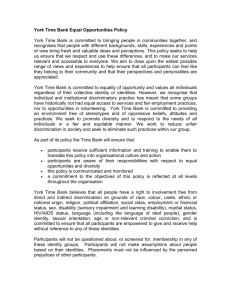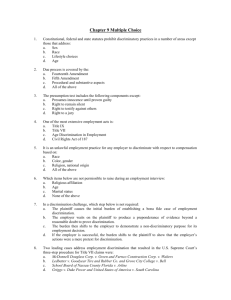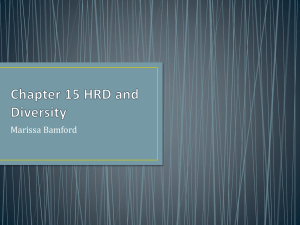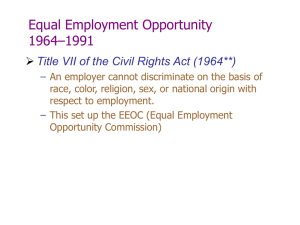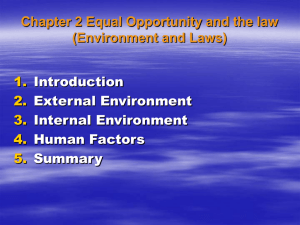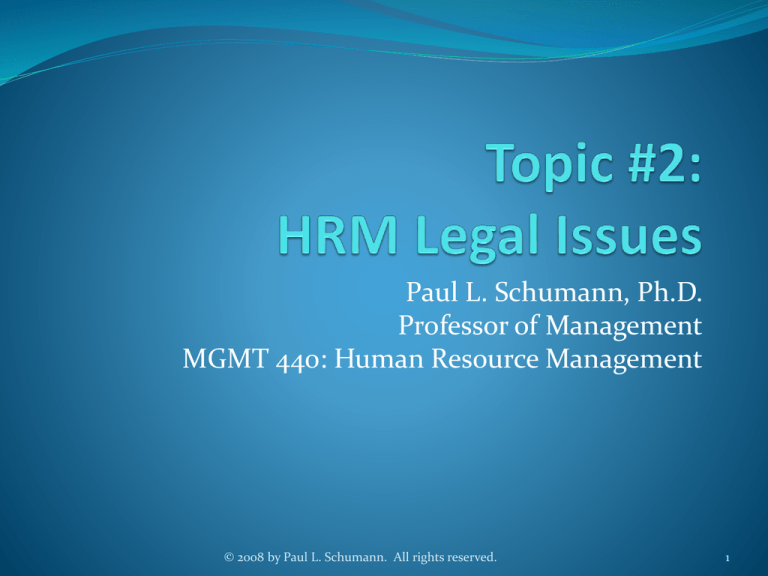
Paul L. Schumann, Ph.D.
Professor of Management
MGMT 440: Human Resource Management
© 2008 by Paul L. Schumann. All rights reserved.
1
Outline
Definition of Employment Discrimination
Protected Characteristics
Major US Federal Laws
Affirmative Action
Proving Illegal Discrimination
Remedies
2
Definition
Employment discrimination: to make an employment
decision, not on the basis of legitimate job-related
factors, but rather on the basis of false stereotypes and
prejudices
Any employment decision
Fail to use job-relevant factors, such as:
Essential job qualifications
Job performance
Instead, use false stereotypes and prejudices
3
Protected Characteristics
US Federal Laws: race, color, religion, sex, national
origin, age (if 40 or older), and disability
Minnesota Law: race, color, creed, religion, national origin,
sex, marital status, public assistance status, local
commission membership or activities, disability, sexual
orientation, & age
4
Major US Federal Laws
Equal Pay Act of 1963
Civil Rights Act of 1964 (CRA) Title VII
Amended by Civil Rights Act of 1991
Age Discrimination in Employment Act of 1967
(ADEA)
Americans with Disabilities Act of 1990 (ADA)
5
Equal Pay Act
Forbids: sex discrimination in pay when the employees
perform essentially the same job in the same
establishment
Examples of legal pay differences for men & women
doing the same job:
Pay based on seniority and man & woman have different
seniority
Pay based on job performance and man & woman have
different job performances
Any factor other than the sex of the employees
6
Civil Rights Act Title VII
Forbids: any kind of employment discrimination based
on a protected characteristic
Protected characteristics: race, color, religion, sex, &
national origin
Administered: Equal Employment Opportunity
Commission (EEOC)
http://www.eeoc.gov/
7
Civil Rights Act Title VII (more)
Additional examples of prohibited sex discrimination:
Discrimination based on pregnancy
Harassment based on sex (sexual harassment)
Quid pro quo sexual harassment
Hostile environment sexual harassment, defined by:
Frequency of discriminatory conduct
Severity of discriminatory conduct
Physically threatening vs. mere offensive utterance
Unreasonably interferes with victim’s job performance
8
Civil Rights Act Title VII (more)
Sexual harassment (more)
Employer (company) liability for harassment by a supervisor:
If there are adverse tangible job consequences, then the
employer is liable unless it can prove a non-discriminatory
reason for the adverse tangible job consequence
If no adverse tangible job consequences, then the employer
can defend itself if:
The employer exercised reasonable care to prevent and to
promptly correct the harassing behavior, AND
The alleged victim unreasonably failed to use the employer’s
procedures
9
Civil Rights Act Title VII (more)
Sexual harassment (more)
Employer (company) liability for harassment by a co-worker:
Did the employer know, or should the employer have known,
about the behavior?
Did the employer take immediate and effective corrective steps
when the behavior was discovered?
Same ideas for racial harassment, color harassment,
religious harassment, national origin harassment, age
harassment, or disability harassment
10
Age Discrimination in Employment
Act (ADEA)
Forbids: employment discrimination based on age for
individuals who are 40 or older
Mandatory retirement at a particular age?
Administered: Equal Employment Opportunity
Commission (EEOC)
http://www.eeoc.gov/
11
Americans with Disabilities Act
(ADA)
Forbids: employment discrimination based on
disability
Definition of disability: something that substantially
limits one or more major life activities, considering:
Nature and severity of impairment
Duration of impairment
Expected long-term impact
Administered: Equal Employment Opportunity
Commission (EEOC)
http://www.eeoc.gov/
12
ADA (more)
Requires: employers must make reasonable
accommodations that are not an undue hardship to
the organization for people with disabilities
To decide reasonable accommodation:
Nature of the job: the essential job duties
Cost of the accommodation
Size of the organization (impact of cost)
Other factors (e.g., union contract)
13
Affirmative Action Plans (AAP)
When?
Voluntary AAP
Court ordered AAP
Required AAP
Company sells to the US government (government contractor)
Executive Orders 11246 & 11375 require companies with federal
contracts to develop affirmative action plans (AAPs)
Enforced by the Office of Federal Contract Compliance
Programs (OFCCP)
http://www.dol.gov/esa/ofccp/
14
AAP (more)
AAPs have 4 parts:
Utilization analysis
Availability analysis
Identification of problem areas
Corrective actions (with goals and timetables)
15
Proving Illegal Discrimination
Selection Ratios (SR) play an important role
SR Overall = # hired / # applicants
SR Men Overall = # men hired / # men applicants
SR Women Overall = # women hired / # women applicants
SR Hurdle = # pass hurdle / # start hurdle
SR Men Interview = # men pass interview / # men
interviewed
SR Women Interview = # women pass interview / # women
interviewed
16
Proving Illegal Discrimination
3 steps in the court case:
Prima facie case
Plaintiff presents evidence consistent with illegal employment
discrimination
Employer’s rebuttal
Company presents its defense
Plaintiff’s rebuttal
Plaintiff presents evidence that casts doubt on the company’s
defense
17
Prima Facie Case
Plaintiff presents evidence of:
Disparate treatment: different policies or practices
Adverse impact (disparate impact): same policies or
practices, but different effects
T-test for equal Selection Ratios (SR)
80% (4/5ths) Rule:
Calculate the SR for each group
SRs Overall & SRs for each hurdle in the hiring process
For each, find the largest SR and compute 80% of that SR
If the SR of any other group is less, then there’s evidence of
adverse impact for that hurdle or overall
18
Example of 80% Rule
#
Applicants
White
Latino
Black
100
50
15
#
Hired
Selection
Ratio
60
60/100 =
60%
25
25/50 =
50%
5
5/15 =
33.33%
Highest SR Overall = 60% (Whites)
80% of highest SR = .80 × 60% = 48% (this becomes the floor)
If the SR of any group is less than 48%, then evidence of adverse impact
Evidence of adverse impact against Blacks, but not Latinos
19
Example of 80% Rule
White
Black
#
Applicants
103
51
# Pass
Test
SR
Test
# Pass
Interview*
74
25
6
10
SR
Interview
#
Hired
SR
Overall
6
10
*Only interviewed applicants who had passed the test.
Conclusions:
Test: evidence of adverse impact against Blacks
Interview: evidence of adverse impact against Whites
Overall: evidence of adverse impact against Whites
20
Employer’s Rebuttal
Company presents evidence for its defense:
Bona fide occupational qualification (BFOQ)
Show that a particular religion, sex, or national origin (not
race or color) is itself a legitimate job qualification
Essence of the business
Essential job qualifications
Job relatedness or business necessity
Show that the challenged practice is related to the job
Example: an employment test has adverse impact; show that
the test is valid (test scores are strongly correlated with job
performance)
21
Employer’s Rebuttal (more)
Bona fide seniority system
Legal affirmative action
Specific, credible evidence of past discrimination:
Conspicuous imbalance
Narrowly tailor the affirmative action remedy:
Goal: match qualified percentages (eliminate the imbalance)
Temporary
Must not unduly trammel the majority (can’t be an absolute
bar to the majority group)
22
Proving Illegal Discrimination
3 steps in the court case:
Prima facie case
Plaintiff presents evidence consistent with illegal employment
discrimination
Employer’s rebuttal
Company presents its defense
Plaintiff’s rebuttal
Plaintiff presents evidence that casts doubt on the company’s
defense
23
Remedies
If employer guilty, court can order:
Injunction
Remedial actions (e.g., reinstatement)
Compensatory damages
Punitive damages: disparate treatment cases only &
amount limited by caps
24
Outline
Definition of Employment Discrimination
Protected Characteristics
Major US Federal Laws
Affirmative Action
Proving Illegal Discrimination
Remedies
25

